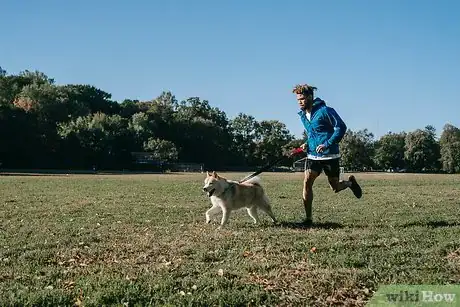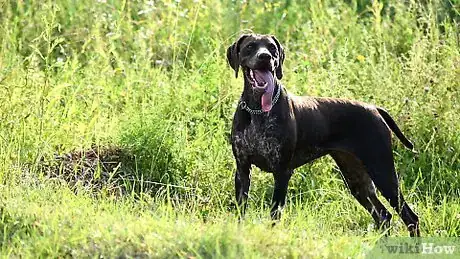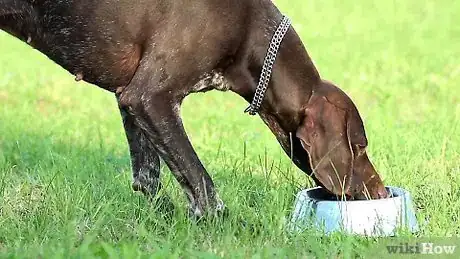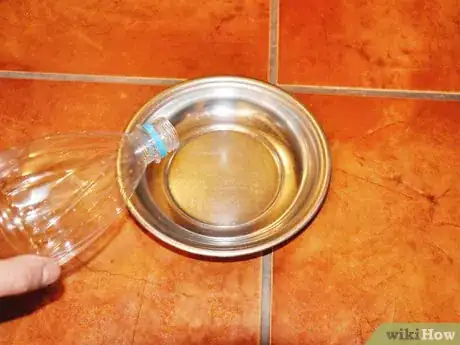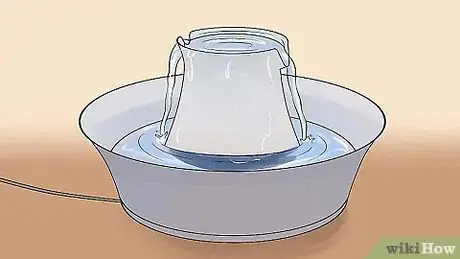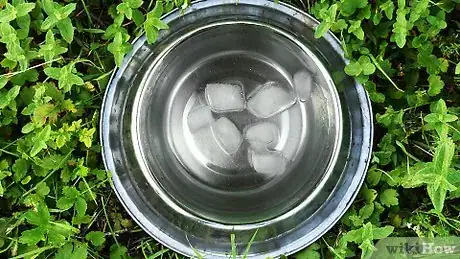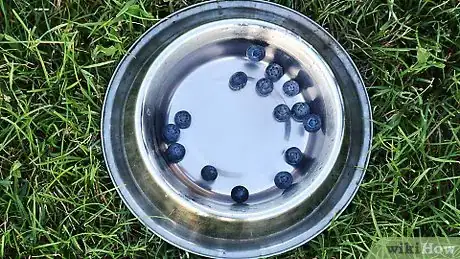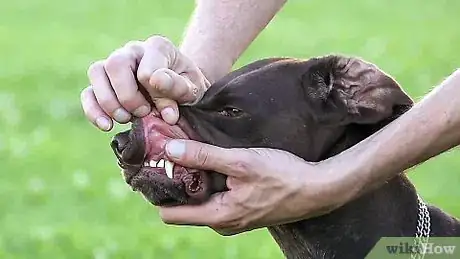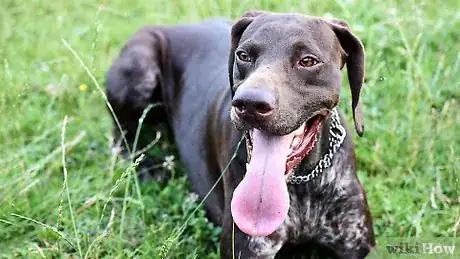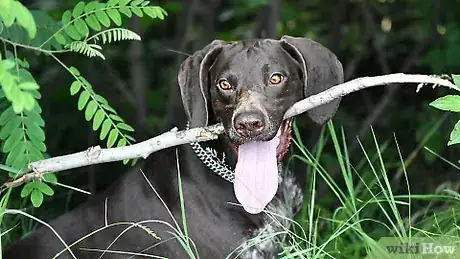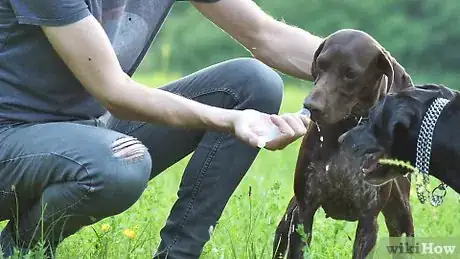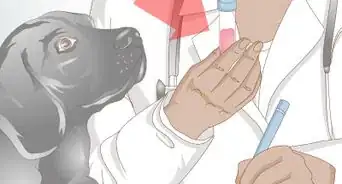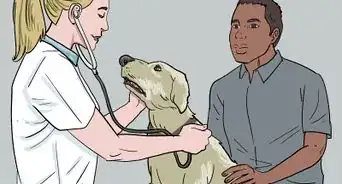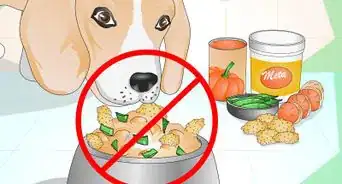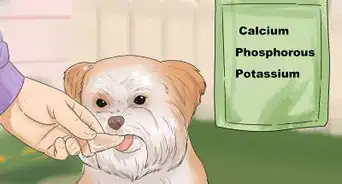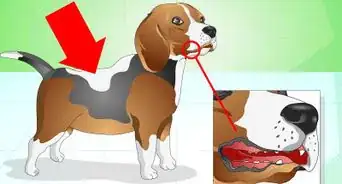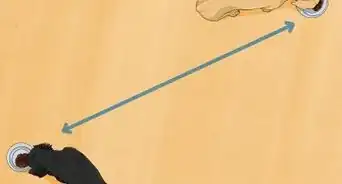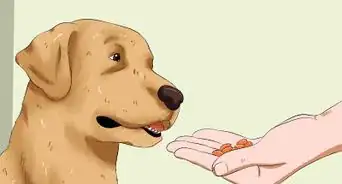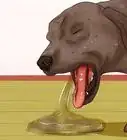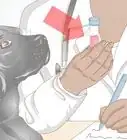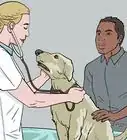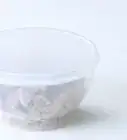This article was co-authored by Melissa Nelson, DVM, PhD. Dr. Nelson is a Veterinarian who specializes in Companion and Large Animal Medicine in Minnesota, where she has over 18 years of experience as a veterinarian in a rural clinic. She received her Doctor of Veterinary Medicine from the University of Minnesota in 1998.
wikiHow marks an article as reader-approved once it receives enough positive feedback. This article has 26 testimonials from our readers, earning it our reader-approved status.
This article has been viewed 639,806 times.
Healthy dogs are usually good at managing their own water intake, although this is less true of young puppies and elderly dogs. Unless there are signs of serious health issues, your dog will most likely get enough water after a few minor changes to water bowl placement and diet.
Steps
Daily Tactics
-
1Exercise the dog. Dogs need daily exercise, such as a brisk walk or playing in a park or backyard. If your dog doesn't get enough exercise, it may not be losing much moisture to panting, and so won't be as thirsty as a healthily active dog.
- On long walks, bring along water and give the dog a swallow every 10 minutes or so. This can help get the dog in the habit of drinking regularly at home.
- You should only exercise a previously healthy dog. If your dog is elderly or ill, ask your vet about better options.
-
2Feed the dog wet food. Wet food contains a great deal of water already, usually marked on the can as "% moisture content." Replace some or all of the dog's dry food with wet, checking the label or a vet's recommendation to determine how much food the dog needs.
- Alternatively, soak dry food in a bowl of water for 30–60 minutes before giving it to your dog.
Advertisement -
3Make food only available at mealtimes. Feed your dog once or twice a day, according to your vet's recommendation or the label of your dog food. If food is constantly available, some dogs will mistake thirst for hunger.
-
4Let the dog out to pee whenever necessary. If your dog is stuck indoors for 8 hours at a time, it could be avoiding water because it's learned that causes an uncomfortably full bladder. Let your dog out to pee every few hours or train it to use a puppy pad.
Arranging the Water Dish
-
1Give the dog constant access to water. In a multistory home, put a bowl of water on each floor the dog has access to. If the dog spends part of the day outdoors or shut in a room, put an additional bowl of water in these locations.
- Try to keep these "water stations" in the same place so your dog knows where to look for water.
- A dog tied outside may get its chain or rope tangled, preventing it from accessing the water dish.[1] If there is no alternative to tying it up, keep the area free from obstructions and place the water dish next to the stake. The water bowl may also get knocked over by the rope or chain, so check it often, replenishing the water as necessary.
-
2Change the water frequently. Empty the water bowl daily and rinse out any debris before refilling it, then wipe the sides with a paper towel. Change the water again whenever you notice hair or dirt floating in it, or whenever the water level is getting low. During hot weather, you may need to check the bowl every couple hours.
- Thoroughly wash and dry the water bowl at least once a week. If the bowl gets dirty, wash it more often.
- Drinking dirty water can put your dog at risk of developing urinary tract infections, so providing fresh water and keeping the bowl clean is important for your dog’s health.[2]
-
3Consider a pet fountain. These bowl-sized water fountains may be more attractive to dogs that prefer running water, or young puppies who aren't used to drinking from a bowl. These are also easier to find for dogs with vision problems.
-
4Add ice cubes on hot days. Many dogs prefer drinking cold water. Toss in a couple ice cubes. Do this while the dog is watching, and it may come over to investigate.
-
5Make the water more exciting. If you don't want to buy a fountain, try shaking the bowl of water instead, or waving a toy over it. Dropping blueberries or other small treats in the water can also convince a dog to drink as it fishes them out.
- If the dog still isn't interested, try again after replacing the doggie bowl with an ordinary cup or bowl with a different shape or color.
Addressing Serious Dehydration
-
1Look for signs of dehydration. Most healthy dogs are pretty good at managing their own water consumption. Check for the following signs of ill health or dehydration before you get too concerned:
- Gently pinch a fold of skin at the back of the dog's neck or between the shoulder blades, and let go. If the skin doesn't immediately return to the original position, your dog may be dehydrated.
- Gently press your finger against your dog's gums until the color lightens, then lift your finger. If the gums don't immediately return to the original color, your dog may be dehydrated.[3]
- Other possible signs of dehydration include lethargy, loss of appetite, or a change in the amount or color of your dog's urine. By themselves, these are not cause for urgent concern unless they are severe or last more than a day.
-
2Know the risk factors. Life stages and medical issues can increase the frequency and severity of dehydration. Err on the side of caution if any of the following apply to your dog:
- Just as hot weather can dehydrate a person, it can also dehydrate your dog. If it's hot, make sure that your dog is drinking enough.
- Vomiting, diarrhea, or excessive panting or drooling can all cause dehydration if the dog does not drink more water to compensate.
- Similarly, kidney disease and other chronic illnesses can cause dehydration.
- If your dog is diabetic, pregnant, nursing, very young, or very old, take the dog to a veterinarian at the first suspicion of dehydration.
-
3Visit the veterinarian. If your dog demonstrates one of the above symptoms and refuses to drink water, visit a veterinarian as soon as possible. The veterinarian may give the dog a saline IV or a subcutaneous fluid injection to rapidly restore fluids to the dog.
- A veterinarian will also be able to test for medical problems that could be causing dehydration, such as kidney disease. After diagnosis, the vet may prescribe medication or a special diet.
Warning: Always call your vet if your dog refuses to drink for more than a day, even if it doesn’t show any other symptoms. This can be a sign of a serious health issue.[4]
-
4Give the dog rehydration fluid. If your dog shows symptoms of dehydration and you can't get to a veterinarian immediately, dilute Pedialyte rehydration fluid with an equal amount of water and give about 1 cup (240 mL) of the mixture to your dog once an hour.[5] Pedialyte is available at drug stores.
- Do not mix this with any other ingredients, or you could cause further damage to the dog.
- While other rehydration fluids are available, consulting a veterinarian before using them is recommended whenever possible.
- Inhabitants of the U.S. can use the Pedialyte website to locate the nearest store that carries it.
-
5Add flavor and electrolytes to the water. If you can't find any Pedialyte, pour a little low-sodium chicken broth or diluted carrot juice into the water. This can help replenish electrolytes lost to dehydration, and may make the water more enticing to your sick dog.
-
6Use a syringe if necessary. If your sick dog completely refuses to drink, fill a plastic, needleless syringe with water and squirt it into your dog's mouth. Squirt in the dog's cheek, not directly down the throat, to prevent choking.
Expert Q&A
Did you know you can get expert answers for this article?
Unlock expert answers by supporting wikiHow
-
QuestionIf your dog drinks any milk will it kill them or make them very sick?
 Melissa Nelson, DVM, PhDDr. Nelson is a Veterinarian who specializes in Companion and Large Animal Medicine in Minnesota, where she has over 18 years of experience as a veterinarian in a rural clinic. She received her Doctor of Veterinary Medicine from the University of Minnesota in 1998.
Melissa Nelson, DVM, PhDDr. Nelson is a Veterinarian who specializes in Companion and Large Animal Medicine in Minnesota, where she has over 18 years of experience as a veterinarian in a rural clinic. She received her Doctor of Veterinary Medicine from the University of Minnesota in 1998.
Veterinarian
-
QuestionCan we feed milk to dogs and cats?
 Melissa Nelson, DVM, PhDDr. Nelson is a Veterinarian who specializes in Companion and Large Animal Medicine in Minnesota, where she has over 18 years of experience as a veterinarian in a rural clinic. She received her Doctor of Veterinary Medicine from the University of Minnesota in 1998.
Melissa Nelson, DVM, PhDDr. Nelson is a Veterinarian who specializes in Companion and Large Animal Medicine in Minnesota, where she has over 18 years of experience as a veterinarian in a rural clinic. She received her Doctor of Veterinary Medicine from the University of Minnesota in 1998.
Veterinarian
Warnings
- If your dog finally starts drinking after much convincing, let it drink in peace instead of praising it. Too much attention can distract the dog from the water bowl.⧼thumbs_response⧽
- Don't let the dog drink from the toilet; this can be a source of illness-causing bacteria.[7]⧼thumbs_response⧽
References
- ↑ http://www.aspca.org/pet-care/dog-care/dehydration
- ↑ https://www.akc.org/expert-advice/health/urinary-tract-infections-uti-in-dogs/
- ↑ http://canigivemydog.com/pedialyte
- ↑ https://www.humanesocietyhbg.org/wp-content/uploads/2020/01/Signs_of_Dehydration_in_Your_Dog.pdf
- ↑ http://canigivemydog.com/pedialyte
- ↑ https://www.wellpet.org/dog-not-eating-drinking/
- ↑ http://www.aspca.org/pet-care/dog-care/dehydration
About This Article
To get your dog to drink water, make sure it has constant access by placing a bowl on all floors of your home. Change the water whenever you see it getting dirty, and add ice cubs on a hot day to make it more enticing. If your dog is showing signs of dehydration, like lethargy or low urine levels, take it to the vet right away and help it rehydrate by giving it diluted Pedialyte or water with a bit of chicken broth or carrot juice. For more symptoms of dehydration and ways to help your dog drink more water day to day, read on!
